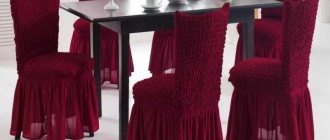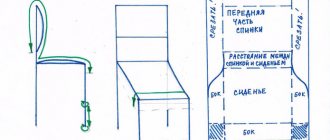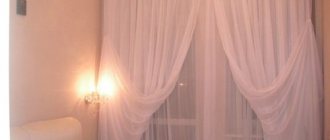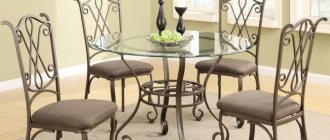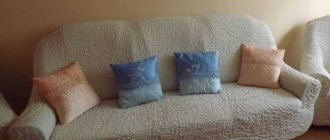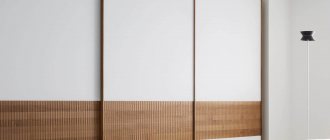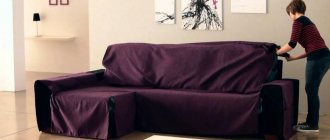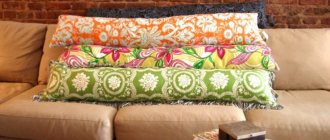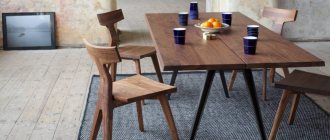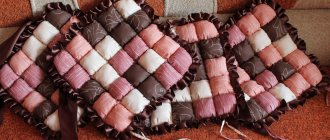Renew kitchen and dining room furniture if it has lost its former appearance or is simply boring, without special expenses? There is a solution! Textile chair covers are becoming increasingly popular. You can order them from a specialized tailoring studio or make them yourself. We will describe both options with examples.
Chair covers can be ordered from a specialized tailoring studio or made by yourself
Various options for chair covers
First, let's look at the main functions of chairs, there are only two of them:
- Functional component
As functional pieces of furniture, chairs are used in everyday life for a comfortable position at the table. The most popular chairs are kitchen and dining room chairs. In second place are chairs in offices and work areas.
Striped chair cover
Chair covers for the kitchen with a pattern
Covers with flowers for kitchen chairs
Purple chair covers
Elegant chair covers for dining room
Kitchen chairs take a beating several times every day when we have breakfast, lunch, dinner, or receive guests. In this regard, their wear and tear is maximum: the upholstery gradually wears off and becomes dirty, the legs become chipped or scratched.
If there are children and animals in the house, then the factor of possible mechanical damage to the chairs increases (scratches, cuts, drawn or painted elements, stains that cannot be washed off).
The above can be avoided by using replaceable textile covers for kitchen and dining room chairs. Firstly, they will cover the shortcomings. Second, protect or preserve integrity. Thirdly, the covers can be changed or washed. You can't do this with a whole chair. Fourthly, the money spent on sewing chair covers is several times less than the cost of a new set of chairs.
Replacement textile covers for chairs
White chair covers for the kitchen
Purpose of chair covers
This product performs several functions simultaneously.
The covers protect the chairs from dirt and premature wear of the upholstery and paintwork.
Chairs equipped with covers are much more convenient to use.
In public places, the use of chair covers creates an appropriate atmosphere and makes it easier to maintain cleanliness.
Covers serve as an excellent addition to the interior and can extend the life of old chairs.
In a home environment, covers made from durable material will help protect chairs from scratches and dirt, transform the interior of the room, and give old but beloved chairs a new life.
In restaurants and cafes, covers add a special solemnity to the atmosphere.
In offices, hospitals and other public places, covers protect chairs from wear and tear.
- Do-it-yourself bead brooch - 105 photos and video description of how to quickly and easily weave a brooch
DIY bird feeder - step-by-step master class and ideas for beginners and schoolchildren (155 photos)
Do-it-yourself beads: 120 photos and video description of how to weave beads
Scope of application
Most often, chair covers can be seen in home environments. They are especially in demand in the kitchen or children's room.
In office premises, medical and educational institutions, the use of covers is also justified.
Luxurious covers decorate furniture in the offices of high-ranking officials and very wealthy people. Such products are very expensive and are a kind of indicator of the status of the owner.
Creating a unique case requires craftsmanship, high-quality materials, and the imagination of a talented craftsman.
You can try your hand at creating a stylish interior addition at home.
- Do-it-yourself dolls made of fabric - 145 photos and video description of how to sew a beautiful doll quickly and easily
- How to sew curtains for the kitchen - a detailed description of how and what to sew curtains for the kitchen from (video + 135 photos)
Do-it-yourself felt toys: ideas, patterns, templates and felt patterns (135 photos and videos)
Options that are easy to use
Let's look at all the options that you can easily do with your own hands. All the nuances and step-by-step implementation are below.
We sew a cover for a chair with a back
- After we have measured the height of the back, legs, and width of the chair, we make a pattern of three elements: rectangles covering the sides and the back with the seat. Don't forget to add a couple of centimeters to the seams.
- Transfer the pattern to the fabric. Since we are dealing with rectangular parts, you can use a ruler for greater accuracy.
- Carefully cut out all the details, taking into account the shared thread.
- First of all, we sew the side edges.
- Then we move on to the side and bottom sections of the back of the back. They should be folded and then stitched.
- Sew the side parts to the seat.
- We tuck and stitch the sections of the side and front parts of the product.
- Ready-made covers can be decorated with a bow or other decor on the back of the chair.
Advice Are you sewing for the first time and doubt your abilities? Try making a test piece first from inexpensive fabric, or at least basting it by hand.
Jeans option
We sew a simple seat
The easiest option, which is suitable even for beginners, is a regular stool seat. It's fairly quick to sew.
Step-by-step instruction
- We make a template from cardboard or other material according to the shape of the stool seat;
- using the resulting pattern, we cut out three parts of the same shape and size from the fabric (for the front, back side + padding polyester);
- We place the padding polyester between two pieces of fabric and secure it with pins;
- to quilt the future seat, you need to sew even lines parallel to each other;
- we baste the pre-prepared bias tape for edging, leaving the ends as future ties;
- We carefully fold the ties in half and stitch them on a typewriter;
- We sew bias tape on the sides of the product using a machine.
Advice If you plan to sew several identical covers at once, you should cut them all at once. This will save fabric.
Easy to do it yourself
Elastic cover for a round stool
Such an accessory can be sewn even from a small piece of fabric.
Step-by-step instruction
- First, as usual, we make a pattern. In order not to bother with measuring instruments when calculating the diameter, you can simply attach a sheet of cardboard or newspaper to the surface of the stool, then cut it along the contour.
- We transfer the drawing to a new sheet of paper, adding a few centimeters along the contour.
- Based on the resulting template, we cut out the piece from the fabric.
- We put an elastic band on the edge of the fabric, fold the fabric, and stitch it.
- Our cover is ready - all that remains is to put it on the stool.
Tip To add softness, you can sew foam rubber or synthetic padding into the seat.
Provence style
Crochet chair covers
A knitted cover can be an interesting option for decorating a room. Crocheting will take more time than sewing a simple pattern, but the result will be a special and original item. Crocheted furniture will look especially cozy in winter, as it creates an atmosphere of comfort and warmth.
Most often, round or square models are crocheted for seating stools. Let's look at an example of knitting a simple round cover:
- We make the upper part from rows of lush columns, separated by short chains of air loops.
- We make the hem by knitting several rows in stitches without adding. This way they will form an even side (for greater stability we make the side higher).
- In the last row we knit air loops - at the end you can insert a fixing elastic band or cord into them to secure the product to the stool.
An interesting option for decorating a room
Using various knitting patterns, you can knit absolutely any model with your own hands. For example, the so-called flower cover or models crocheted from motifs (they can also be decorated with crocheted flower appliqués).
Advice There is no need to be shy in choosing bright, rich colors. Multi-colored knitting threads can add originality and enliven the interior.
Cover made from an old sweater
If knitting is not your thing, but the beauty and comfort of knitted covers haunt you, try making them from an old sweater. Any item of the desired size and color, knitted with knitting needles, large or medium knit, is suitable for this.
The edges of the sweater must be carefully processed so that the resulting item does not unravel in the future.
The pillow will add comfort when sitting
Depending on the size of the sweater, you can sew a cape only on the seat or on the back, or you can get a whole accessory, for example, by using several old products. Large volumetric patterns in delicate bed colors look especially atmospheric.
Tip Knitted items can stretch, so it is better to make them 1-2 cm smaller in width or diameter.
You can also sew models not only from knitwear, but also from other old things in good condition. For example, from jeans or coats that have become too small. The main thing is that the style of the resulting product matches the interior of the room.
On a children's chair
Chair covers in a children's room are more relevant than anywhere else. Bright, elegant fabrics can decorate the interior of a nursery and interest little fidgets. In addition, they are indispensable in protecting furniture from dirty handprints, spilled drinks or traces of children's creativity.
When sewing such accessories for the nursery, you can give free rein to your imagination: images of cartoon characters, funny animals, flowers, cars, princesses - everything that the child will be incredibly happy about.
The product is sewn according to a standard pattern, as for a regular stool. All measurements are taken in advance. Very often, for children's furniture, capes are sewn only on the back: two rectangular pieces are cut out and sewn in three places. At the end, you can apply a design or decorate it with fabric, sew on “bunny ears” or, for example, design it in the shape of a snowman.
In the interior of a children's room
Tip From the inside out, so that the cover does not slip, you can sew decorative laces that will be tied behind the legs of the stool. You can also use buttons, ribbons or elastic.
On a high chair
Covers made of easily washable fabric on children's high chairs are irreplaceable. They can make life much easier for young parents, since keeping a baby’s chair clean is almost impossible. In addition, the cover will provide additional protection for the child from slipping and, as a result, bruises.
If you decide to sew yourself, you need to carefully choose the fabric: it should not cause irritation to the baby. The best choice is thick cotton for the inner part, softer cotton or lawn for the outer part and padding polyester as a small layer.
For the bride and groom
- The pattern can be made by removing the pattern from the old cover, or use a ready-made pattern for a standard high chair.
- Having cut out all three parts of the product according to the pattern, we put it together (wrong side to each other), make a basting, and then sew it on a typewriter.
- Turn it right side out, fold the unstitched edges inward, then stitch again. We also sew on pockets, ties or straps, if necessary.
On an office chair
A computer chair can very quickly lose its appearance due to scuffs on the seat. Using a cover, you can update a worn-out chair, make it more convenient, comfortable, or simply liven up your office by decorating an inconspicuous chair with bright decor.
Products with buttons
To quickly sew a model for an office chair, follow the following instructions:
- We apply transparent tracing paper to the parts of the chair (seat and back), and trace along the outline with a pencil.
- Add seam allowances to the resulting patterns (2 cm for the back, 5 cm for the seat to hem the edge and insert elastic there), cut out and cut the fabric.
- For the back, we cut 2 identical parts, which are then sewn on three sides (except for the bottom).
- For sitting, you can sew a cover with a skirt that will cover the legs. Or with an elastic band that will fit the seat tightly. This model is suitable for an office chair on wheels.
Simple and stylish option
Patchwork style
Patchwork (or sewing from scraps) can be a great idea when you need to sew a chair cover and have a large amount of small scraps of fabric collected at home. In this case, it does not matter at all what color they are or how similar the pattern is. The peculiarity of this type of needlework is that you can combine pieces of fabric of different texture and color.
To make a patchwork style accessory, you will need to prepare blocks - squares or rectangles of the same size cut out of fabric. Their size and quantity will depend on the size of our future product.
You can use decorative pillows
- Before sewing all the parts together, you need to lay them out to create the desired composition. Here everything depends only on our imagination; for example, we can try to convey a gradient or simply leave a haphazard drawing.
- Then the parts are folded right side inward and stitched together on a typewriter. The fabric is carefully ironed.
This way you can sew a stylish cover for the stool seat. To make it softer and more comfortable, you can add padding polyester inside.
Accessories in the patchwork style will suit the interior in country, Provence, boho styles, and will also decorate a children's bedroom or playroom.
Foot covers
Covers for chair legs are especially relevant in rooms with tiled floors or parquet, which often receive scratches when moving furniture.
They are easy to sew or crochet or knit, they do not require a lot of material and look very cute. Similar knitted “socks” or even “socks” for furniture legs will look especially good with openwork covers for the seat and back, knitted from the same yarn.
Wedding covers
When decorating wedding chairs, the choice of color and fabric usually depends on the style and theme of the celebration. Fabric covers look elegant, but are often expensive. You can save money if you make such products yourself.
Tip To reduce fabric costs, you can only sew capes for the backs of chairs.
When decorating furniture for a wedding, you can do without sewing at all: the chairs are simply wrapped in pieces of fabric and secured with ribbons. Decorate with artificial flowers, lace or a bow (you can secure it with a heat gun or simply sew it on with a needle).
Bride's chair decoration
For wedding decor, guipure, silk, satin, organza or chiffon are usually chosen. The fabric can be either light colors - white, beige, soft pink, cream, or contrasting - red and white, white and orange. Chairs should not be the center of attention, but should organically complement the overall composition.
The design of the bride and groom's chairs may differ from those of the guests. For example, they can be stylized to match the wedding dresses of the newlyweds: a white tailcoat with a black bow tie for the groom and a long white dress with flowers for the bride.
Guipure, silk, satin, organza or chiffon are usually chosen
Tip If you add a large number of ties to chair covers, very often do not sew the pieces together, as the ties will hold them tightly together.
Holiday covers
A theme party, wedding anniversary, bachelorette party or birthday is another reason to decorate the interior, including chairs for guests. Festive decoration will not only delight children, but will also surprise and amuse adults.
For children's birthdays and holidays at home or in kindergarten, you can use decor to turn a piece of furniture into an element of a game or even an educational toy. For example, make a kitchen cover in the form of a stove, where kids will practice cooking, or in the form of cars for role-playing games.
New Year or Christmas models can be designed in the form of Santa Claus, snowmen, deer, bear cubs, gingerbread men and other favorite characters. This holiday will be remembered for a long time!
And when decorating for Halloween, you can’t do without ghosts, pumpkins, bats and cobwebs. Even a regular case in bright orange or in combination with black will create an amazing holiday atmosphere for both children and their parents.
The first stage of making chair covers
Before you sew chair covers with your own hands, it is important to choose the product model wisely.
Chair covers are a prominent part of the room's design, so they should be in harmony with the rest of the home furnishings in style and color scheme.
Selection of material
Having decided on the product model, it is very important to choose the appropriate material to bring your idea to life.
The fabric for sewing covers must be dense and abrasion-resistant.
Choosing fabric for sewing
[ads2]
It will not be possible to take any fabric for sewing covers, because not every existing material is suitable. The fabric should be both pleasant and look great on the chair. And one more thing - the fabric must have dirt- and water-repellent properties, have good air conductivity and wash resistance. And you will have to wash chair covers quite often.
We present to your attention the fabrics that are most often chosen for sewing covers, which are already considered classic for use in the kitchen. These materials fully comply with the stated requirements and have been tested in practice.
Crepe satin is an excellent silk fabric that is good to use for creating spectacular folds and gathers on covers. This fabric can be either synthetic or include natural components.
Crepe-satin is a fairly elastic material that is visually similar to satin and silk - it has an attractive shine on the outside, and a matte sheen on the outside. The fabric does not wrinkle and is very wear-resistant. Therefore, taking into account all the stated points, its exquisite appearance in the finished product is guaranteed.
Gabardine. Looking for a thin but dense fabric? Then gabardine will come to your aid. This material can be made of cotton, wool, silk. It also comes in wool blend and synthetic.
How to choose natural gabardine, or at least one that contains natural materials? If the surface of the fabric has a distinct shine, it contains more synthetics. And if there is a matte coating, the material is made using natural ingredients that are superior in composition to synthetics.
Gabardine is resistant to wear, frequent washing and stain removers, and does not lose its shape. It's a very soft, breathable fabric that not only looks good, but also fits well on the chair.
Supplex (lycra) . Elasticity + density + the ability to stretch in all directions are the main advantages of supplex fabric. This material washes well and dries very quickly.
Organza. If you want to choose light and transparent covers for your kitchen chairs, then organza is ideal for you. It is made from silk, polyester or viscose. Another advantage of organza is that it has a unique shine, which is guaranteed by the special technology of its creation.
The surface of the fabric is matte. Sometimes it has shiny inclusions in its structure. Organza is strong, and if it breaks, it is in very rare cases. Almost does not wrinkle. Its structure allows light and air to pass through well.
Atlas. Experts characterize this fabric very simply – as soft and silky. It is stretchy and has a glossy surface. Most often used in making items for the holidays, making it ideal for holiday table covers. From a design point of view, we note: satin is never boring in the interior.
Mesh filigree. This is a special fabric, because it can be suitable for creating covers for kitchen chairs only for the summer version and, most likely, in an open space. Most often, mesh fabric is used to decorate chair covers.
Read about how you can use artificial stone in an original way in your kitchen interior: photos with examples of stone finishing can be seen in the gallery.
Read about the main and most popular options for combining wallpaper for walls here.
Do you know what painting on wet plaster is called? The answer is in the article at:
Brocade. Many people have stereotypes that silk and heavy fabrics create a rich atmosphere and if these materials are used for covers in the kitchen, the value of the room will increase. Yes, undoubtedly, it will definitely not remain a loser. At the same time, you don’t even have to combine silk and heavy fabrics, because we have brocade - a heavy silk-based fabric.
Its special feature is that the surface of the fabric is decorated with metal threads that form various patterns. But, if previous materials do not have problems with washing, then you need to be careful with brocade. The best thing to do is take it to the dry cleaner.
Note! Quite often, furniture fabrics are used to make chairs. Why this choice? The answer is very simple. The fact is that they practically represent the same drapery as on furniture, that is, they have the same qualities.
Covers for different rooms
The most durable covers are required for chairs in the kitchen. They are more susceptible to moisture, high temperatures, dirt and abrasion.
For the living room, you should choose stylish products that harmonize with the interior of the room.
Chair covers for a child's room should be fun and easy to wash.
For organizations and institutions, the best option would be durable products in non-marking colors.
Sewing a chair cover
To sew furniture covers, you will definitely need a sewing machine. Considering the density of the material, it is necessary to select a sufficiently thick thread and needles of the appropriate number.
Patterns for chair covers are drawn with your own hands based on accurate measurements of all overall dimensions of the chair.
You will need to make a drawing of the chair and all its parts. The paper elements of the pattern can be “tried on” to the chair for clarification.
Making a pattern is quite a complex job that requires some experience. The final result directly depends on how correctly the parts of the pattern are drawn.
The outlines of the parts are applied to the material with a piece of soap or chalk. It is not recommended to use a marker or ballpoint pen. Traces from them will not be washed off subsequently.
The fabric is cut along the contour taking into account seam allowances.
The parts are connected using smooth machine stitching. The work should be done very carefully.
The most difficult part of the job will be making a cover that completely covers the entire chair. When cutting such a product, it is very important to correctly take all measurements and make an accurate pattern.
How to take measurements from a chair correctly
As in most cases, the first measurement is taken along the longest side - the height of the chair. If necessary, the length of the cover can be adjusted. After this, the height from the floor to the seat is measured. If the base of the chair is solid, without legs, then the sides are measured, and if with legs, then the distances between them, taking into account their own thickness. Measurements should be taken at the widest point, usually near the floor. Many people make the mistake of measuring the backrest in width and height between the frame - you need to find out the full parameters. You need to measure the seat in a different way. If it is raised relative to the level of the frame, then the readings are taken along the boundaries of the seat. And if at the same height, then along the edges of the entire structure, but if you need to sew a cape only on the seat, then it is better to measure only the soft part. A seat of this size will be enough for comfortable sitting.
Simple chair cover
For beginning craftsmen, it is recommended to start working with the simplest models to perform.
For example, the cover may not completely stretch over the back of the chair, but partially cover it and the seat.
For fastening, the product is supplemented with ribbons, braid or other fastening parts.
It is easier to make a rectangular cover pattern. And the sewing technique for this model will be much simpler.
When making such a model, it is important to think through the elements that will help secure the cover to the chair for ease of use.
Trying on and sewing tips
When the drawings have already been prepared, all that remains is to make the layout and find out the material consumption. When sewing chair covers, an optical illusion occurs, as if only a little fabric is needed. Seams and decorative elements (ruffles, folds) “require” an additional amount of material and forethought from the craftsman. Beginners will need an “experimental” case. The pattern is placed on a perfectly flat surface. Dimensions are double-checked vertically and horizontally. Allowances are made along the edges. After eliminating all the shortcomings, shapes are cut out of the fabric with scissors. Trying is carried out several times. Based on its results, adjustments are made. If necessary, the workpiece is ripped apart, and again you will need to create a “test” cape. The product should take on its final form after it exactly matches the contours of the chair. The cut is sewn on a sewing machine. It must be borne in mind that the parts must be placed in the direction of the grain thread. Straight covers will fit better if their seams are equipped with zippers.
Using a ready-made pattern, you can practice and make patterns, fitting and sewing a cover for a certain type of chair.
Kitchen chair cover
For kitchen chairs, a cover is often sewn that covers only the seat. In order to sew a cover for a chair seat with your own hands, you also need to take measurements and draw a pattern.
Measure the size of the seat. The pattern will be rectangular in shape.
The fabric is cut with allowance for seams.
Operating procedure
- First of all, you need to sew a soft base to the wrong side of the part with stitches, if it is provided for by the model.
- Then the main part of the product and its lining are folded “face” inward, aligned along the edge and machine stitched on three sides.
- The product must be turned inside out and ironed.
- Sew up the remaining edge.
- A braid is sewn along the edges to secure the cover.
The work is finished.
Seat care
The soft removable part of the stools must be washed periodically as it tends to get dirty regularly. This is especially true for kitchen stools.
Washing should be carried out in a gentle mode at a temperature of 40 degrees, so as not to deform the base.
It is recommended to dry the product flat out, in a place where there is no direct sunlight, otherwise the design will fade.
Chair back cover
If desired, sew a cover for the back of the chair separately with your own hands.
Work begins by measuring the dimensions of the back of the chair: height, width.
Taking these measurements into account, a pattern is drawn. The simplest version of the pattern will have the shape of a rectangle.
When taking measurements, you need to take into account the width of the side of the back.
Operating procedure
- When cutting, be sure to leave seam allowances.
- The parts are placed right sides down and a machine seam is made on three sides of the workpiece.
- The product can be turned out, ironed and placed on the back of a chair.
The work is finished.
With your own hands, you can sew an original and comfortable chair cover, which, in addition to household functions, will serve as an excellent interior decoration.
Variety of design solutions
Thanks to the cover, the most ordinary chair with a back can become a work of applied art. A one-piece case made of noble fabric can be decorated with exquisite embroidery.
Modern urban style allows you to “wear” a stylized sweater or shirt from your wardrobe on this piece of furniture. Surviving fragments of old clothing can become material for patchwork fabric.
We recommend reading:
- DIY foamiran flowers: ideas for beginners and options for making crafts (125 photos)
- Curtains for the nursery: original design ideas and combinations (photos of new items)
- Do-it-yourself pincushion - master class on sewing and features of making a pincushion (130 photos)
The fabric that covers the back side can become a background for appliqués and small panels. Almost all patterns can be adapted to crochet.
When decorating furniture for special occasions - weddings, anniversaries, New Year's or children's parties, special models of covers are used.
Imagination and resourcefulness will help you accomplish the same task using shawls, decorative towels or simply pieces of fabric. They can be secured with bright ribbons, interlaced on the back, using pins and other stylish fasteners.
Photos of DIY chair covers
Tell your friends
